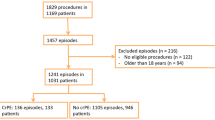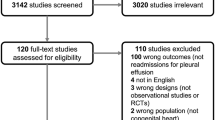Abstract
Pericardial effusion (PE) may require readmission after cardiac surgery and has been associated with postoperative morbidity and mortality. We sought to identify the prevalence and risk factors for postoperative PE requiring readmission in children. A retrospective analysis of the Pediatric Health Information System database was performed between January 1, 2003, and September 30, 2014. All patients ≤18 years old who underwent cardiac surgery were identified by ICD-9 codes. Those readmitted within 1 year with an ICD-9 code for PE were identified. Logistic regression analysis was performed to determine risk factors for PE readmissions. Of the 142,633 surgical admissions, 1535 (1.1%) were readmitted with PE. In multivariable analysis, older age at the initial surgical admission [odds ratio (OR) 1.17, p < 0.001], trisomy 21 (OR 1.24, p = 0.015), geographic region (OR 1.33–1.48, p ≤ 0.001), and specific surgical procedures [heart transplant (OR 1.82, p < 0.001), systemic-pulmonary artery shunt (OR 2.23, p < 0.001), and atrial septal defect surgical repair (OR 1.34, p < 0.001)] were independent risk factors for readmission with PE. Of readmitted patients, 44.2% underwent an interventional PE procedure. Factors associated with interventions included shorter length of stay (LOS) for the initial surgical admission (OR 0.85, p = 0.008), longer LOS for the readmission (OR 1.37, p < 0.001), and atrial septal defect surgery (OR 1.40, p = 0.005). In this administrative database of children undergoing cardiac surgery, readmissions for PE occurred after 1.1% of cardiac surgery admissions. The risk factors identified for readmissions and interventions may allow for improved risk stratification, family counseling, and earlier recognition of PE for children undergoing cardiac surgery.


Similar content being viewed by others
Abbreviations
- PE:
-
Pericardial effusion
- PPS:
-
Postpericardiotomy syndrome
- PHIS:
-
Pediatric Health Information System
- ICD-9:
-
International classification of diseases, ninth revision
- LOS:
-
Length of stay
- RACHS:
-
Risk adjustment for congenital heart surgery
- IQR:
-
Interquartile range
- PDA:
-
Patent ductus arteriosus
- ASD:
-
Atrial septal defect
- VSD:
-
Ventricular septal defect
- EP:
-
Electrophysiology
- OR:
-
Odds ratio
- BT:
-
Blalock–Taussig
- ToF:
-
Tetralogy of Fallot
- AVC:
-
Atrioventricular canal
- TGA:
-
Transposition of the great arteries
- TAPVR:
-
Total anomalous pulmonary venous return
- M:
-
Months
- D:
-
Days
References
Lehto J, Gunn J, Karjalainen P, Airaksinen J, Kiviniemi T (2015) Incidence and risk factors of postpericardiotomy syndrome requiring medical attention: the Finland postpericardiotomy syndrome study. J Thorac Cardiovasc Surg 149:1324–1329
Soloff LA, Zatuchui J, Janton OH et al (1953) Reactivation of rheumatic fever following mitral commissurotomy. Circulation 8:481–493
DeScheerder I, Wulfrank D, Van Renterghem L et al (1984) Association of anti-heart antibodies and circulating immune complexes in the postpericardiotomy syndrome. Clin Exp Immunol 57:423–428
Jones DA, Radford DJ, Pohlner PG (2001) Outcome following surgical closure of a secundum atrial septal defect. J Paediatr Child Health 37:274–277
Miller RH, Horneffer PJ, Gardner TJ et al (1998) The epidemiology of the postpericardiotomy syndrome: a common complication of cardiac surgery. Am Heart J 116:1323–1329
Imazio M, Brucato A, Rovere ME et al (2011) Contemporary features, risk factors, and prognosis of the postpericardiotomy syndrome. Am J Cardiol 108:1183–1187
Heching HJ, Bacha EA, Liberman L (2015) Post-pericardiotomy syndrome in pediatric patients following surgical closure of secundum atrial septal defects: incidence and risk factors. Pediatr Cardiol 36:498–502
Sevuk U, Baysal E, Altindag R et al (2015) Role of diclofenac in the prevention of postpericardiotomy syndrome after cardiac surgery. Vasc Health Risk Manag 11:373–378
Gill PJ, Forbes K, Coe JY (2009) The effect of short-term prophylactic acetylsalicylic acid on the incidence of postpericardiotomy syndrome after surgical closure of atrial septal defects. Pediatr Cardiol 30:1061–1067
Finkelstein Y, Shemesh J, Mahlab K et al (2002) Colchicine for the prevention of postpericardiotomy syndrome. Herz 27:791–794
Imazio M, Brucato A, Rovere ME et al (2011) Colchicine prevents early postoperative pericardial and pleural effusions. Am Heart J 162:527–532
Cheung EW, Sa Ho, Tang KK et al (2003) Pericardial effusion after open heart surgery for congenital heart disease. Heart 89:780–783
Yip SB, Chau MC, Chow WH et al (1997) Pericardial effusion in adults undergoing surgical repair of atrial septal defects. Am J Cardiol 79:1706–1708
Prabhu AS, Ross RD, Heinert MR, Walters HL, Hakimi M (1996) Decreased incidence of postoperative pericardial effusions after cardiac surgery for congenital heart disease. Am J Cardiol 77(9):774–776
Dalili M, Zamani H, Aarabi-Moghaddam M (2012) Pericardial effusion after pediatric cardiac surgeries: a single center observation. Res Cardiovasc Med 1:28–32
Weitzman LB, Tinker WP, Kronzon I, Cohen ML, Glassman E, Spencer RC (1984) The incidence and natural history of pericardial effusion after cardiac surgery—an echocardiographic study. Circulation 69:506–511
Kuvin JT, Harati NA, Pandian NG, Bojar RM, Khabbaz KR (2002) Postoperative cardiac tamponade in the modern surgical era. Ann Thorac Surg 74:1148–1153
Clapp SK, Garson A Jr, Gutgesell HP, Cooley DA, McNamara DG (1980) Postoperative pericardial effusion and its relation to postpericardiotomy syndrome. Pediatrics 66:585–588
Sevuk U, Baysal E, Altindag R et al (2016) Role of methylprednisolone in the prevention of postpericardiotomy syndrome after cardiac surgery. Eur Rev Med Pharmacol Sci 20:514–519
Cantinotti M, Spadoni I, Assanta N et al (2014) Controversies in the prophylaxis and treatment of postsurgical pericardial syndromes: a critical review with a special emphasis on paediatric age. J Cardiovasc Med 15(12):847–854
Jenkins KJ, Gauvreau K, Newburger JW, Spray TL, Moller JH, Iezzoni LI (2002) Consensus-based method for risk adjustment for surgery for congenital heart disease. J Thorac Cardiovasc Surg 123:110–118
Lehto J, Kiviniemi TO, Gunn J et al (2016) Occurrence of postpericardiotomy syndrome admissions: a population-based registry study. Ann Med 48:28–33
Timmis GC, Gordon S, Ramos RG (1971) Recurrent postpericardiotomy syndrome. Its protracted nature and association with atrial septal defects. Mich Med 70:539–542
Alraies MC, Jaroudi WA, Shabrang C, Yarmohammadi H, Klein AL, Tamarappoo BK (2014) Clinical features associated with adverse events in patients with postpericardiotomy syndrome following cardiac surgery. Am J Cardiol 114(9):1426–1430
Concolino D, Pascuzzi A, Pietragalla E, Lia R, Strisciuglio P, Canepa S (2005) High prevalence of isolated pericardial effusion in Down Syndrome. Am J Med Genet 132A:331–332
Hirashima C, Eguchi Y, Kohmura Y, Minakami H, Sato I (2000) Isolated pericardial effusion and transient abnormal myelopoiesis in a fetus with Down’s Syndrome. J Obstet Gynaecol Res 26:303–306
Cilberto GR, Anjos MC, Gronda E et al (1995) Significance of pericardial effusion after heart transplantation. Am J Cardiol 76:297–300
Hauptman PJ, Couper GS, Aranki SF, Kartashov A, Mudge GH, Loh E (1994) Pericardial effusions after cardiac transplantation. J Am Coll Cardiol 23:1625–1629
Cabalka AK, Rosenblatt HM, Towbin JA et al (1995) Postpericardiotomy syndrome in pediatric heart transplant recipients. Immunologic characteristics. Tex Heart Inst J 22(2):170–176
Dogan OF, Duman U, Karagoz T, Ozkutlu S, Ersoy U (2005) Diagnosis of perigraft seroma formation by use of echocardiography after modified Blalock–Taussig shunt. Eur J Echocardiogr 6:385–387
Garcia-Guerata L, Burgueros M, Borches D, Gonzalez V, Jimenez J (1997) Cardiac tamponade after a systemic-pulmonary shunt complicated by serous leakage. Ann Thorac Surg 63:248–250
Just H, Mattingly TW (1968) Interatrial septal defect and pericardial disease: coincidence or causal relationship? Am Heart J 76(2):157–167
Mott AR, Fraser CD, Kusnoor AV et al (2001) The effect of short-term prophylactic methylprednisolone on the incidence and severity of postpericardiotomy syndrome in children undergoing cardiac surgery with cardiopulmonary bypass. J Am Coll Cardiol 37:1700–1706
Wilson NJ, Webber SA, Pettersen MW et al (1994) Double-blind placebo-controlled trial of corticosteroids in children with postpericardiotomy syndrome. Pediatr Cardiol 15:62–65
Hofneffer PJ, Miller RH, Pearson TA et al (1990) The effective treatment of postpericardiotomy syndrome after cardiac operations. A randomized placebo-controlled trial. J Thorac Cardiovasc Surg 100:292–296
Author information
Authors and Affiliations
Corresponding author
Ethics declarations
Conflict of interest
The authors declare that they have no conflict of interest.
Rights and permissions
About this article
Cite this article
Elias, M.D., Glatz, A.C., O’Connor, M.J. et al. Prevalence and Risk Factors for Pericardial Effusions Requiring Readmission After Pediatric Cardiac Surgery. Pediatr Cardiol 38, 484–494 (2017). https://doi.org/10.1007/s00246-016-1540-2
Received:
Accepted:
Published:
Issue Date:
DOI: https://doi.org/10.1007/s00246-016-1540-2




